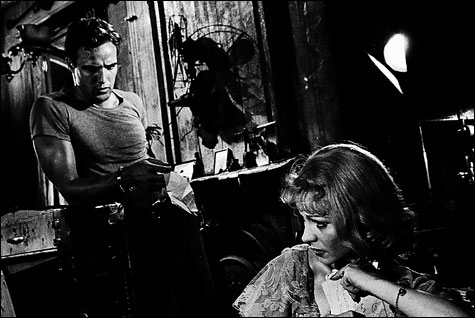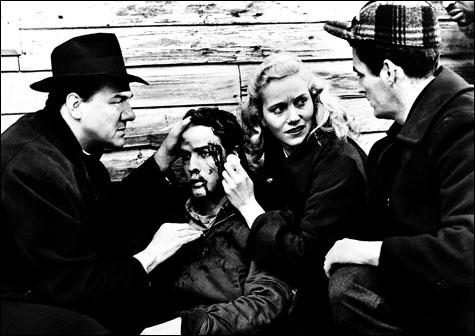
A STREETCAR NAMED DESIRE: Kazan directed Marlon Brando’s two most influential performances — in Streetcar with the equally brilliant Vivien Leigh. |
| “The Complete Elia Kazan” | Harvard Film Archive: July 31–August 24 |
The arc of Elia Kazan's professional life has its origins in the Group Theatre, where he was trained as an actor and performed in the original 1930s productions of Clifford Odets's
Waiting for Lefty and
Golden Boy. By the mid '40s, he'd given up acting to become the first American director to maintain successful simultaneous careers in the theater and in film. In 1947, he staged the Broadway production of
A Streetcar Named Desire, bringing Marlon Brando to the attention of the American theatergoing audience, and he taught the first cohort at the Actors Studio. He also won the 1947 Best Director Oscar for
Gentleman's Agreement.
The complete retrospective of Kazan's movies at the Harvard Film Archive allows us to see, as a kind of triptych, the three distinct stages of his movie career: the pictures he made in Hollywood between 1945 and 1950; his iconic movies, beginning with the film of A STREETCAR NAMED DESIRE (August 22 at 9:15 pm) in 1951 and ending with Splendor in the Grass a decade later; and his disparate final quartet of releases, spread from 1963 to 1976. The series even includes a documentary short, "People of the Cumberland" (screens with Wild River August 7) that he co-directed in 1937 and a couple of glimpses of him as a wiry, intense character actor, in the satirical short "Pie in the Sky" (1934; screens with Pinky), and playing a jazz musician in the 1941 musical BLUES IN THE NIGHT (August 14 at 7 pm). This last was the second and final Hollywood picture he appeared in, and despite the disparaging remarks he later made about himself as an actor, he's quite effective in it.

Given his background in the Group Theatre, which was dedicated to mounting plays built around social and political issues, it's not surprising that half of the first half-dozen movies he directed were social-problem pictures. GENTLEMAN'S AGREEMENT (August 24 at 7 pm) dramatizes Laura Z. Hobson's bestseller about a journalist (Gregory Peck) who pretends to be a Jew in order to expose anti-Semitism as a fact of daily American life. BOOMERANG! (August 21 at 9:15 pm) is the true story of a Connecticut DA (Dana Andrews) who prosecutes the alleged murderer of a beloved local minister, realizes he's got the wrong man, and, bucking vested political interests, proves the man's innocence. PINKY (August 1 at 9:15 pm) is about a light-skinned black woman (Jeanne Crain) who returns to her small Southern town after three years of passing for white in a Northern nursing school.
Gentleman's Agreement is the famous one of this trio, but it's the only one that — except for a vibrant supporting performance by Kazan's old Group colleague John Garfield — isn't much good. It's genteel and Hollywoodized, and the stakes don't seem very high. Pinky is also conventional in many ways (that includes the casting of Crain, a white movie star), but it has surprising elements: in the performances (Crain's among them), in the way Pinky's treatment at the hands of her neighbors often illuminates the worst side of both whites and blacks, and in the moody visual portrait of the shantytown where Pinky moves in with the grandmother who raised her (the great Ethel Waters).
Kazan was committed to authenticity, and his gift for evoking locales and populations through his eye for detail and his skillful, poetic staging and shooting of crowd scenes is apparent early on, in Pinky and Boomerang! as well as in the ingenious, New Orleans–set PANIC IN THE STREETS (July 31 at 7 pm), where the search for a murderer takes on emergency status when the victim turns out to have been the carrier of pneumonic plague. The other tell in this initial period derives, like his problem-picture bent, from his history with the Group, where Stanislavskian (Method) acting received its official tryout: his work with actors is phenomenal. Even his debut film, a bland adaptation of Betty Smith's A TREE GROWS IN BROOKLYN (August 15 at 7 pm), boasts an excellent ensemble, and the work of Andrews, Lee J. Cobb, Sam Levene, and Arthur Kennedy in Boomerang! and Richard Widmark, Paul Douglas, Jack Palance, and Zero Mostel in Panic in the Streets is compelling and memorable.

ON THE WATERFRONT: The scenes on the docks still play as vividly as if you were watching them live.
|
The Method revolutionized American movie acting in the '50s, and Kazan, more actively than any other filmmaker, harvested the first, potent crop of Method stars. He didn't bring Brando to Hollywood, but he directed Bando's two most influential performances, as Stanley Kowalski in Streetcar (opposite the equally brilliant Vivien Leigh) and as Terry Malloy in ON THE WATERFRONT (August 8 at 7 pm). He discovered James Dean, who plays Cal, the tormented, unloved younger brother in the film of John Steinbeck's EAST OF EDEN (July 31 at 7 pm). The erotically charged scenes between Brando and Eva Marie Saint in Waterfront and the delicate romantic ones between Dean and Julie Harris in Eden raised the standard for psychological realism in American pictures. And in Waterfront— probably the most powerful social-problem drama ever made in this country — his raw, improvised-feeling work with his leading actors is combined with the scenes on the docks that still, more than half a century later, play as vividly as if you were watching them live. Kazan insisted on shooting the film on location; by 1956's BABY DOLL (August 21 at 7 pm) — an outrageously sexy Tennessee Williams comedy that's never received its due — he was using non-professional locals in the cast, a practice he continued in his next two pictures, A Face in the Crowd and WILD RIVER (August 7 + 10 at 7 pm).